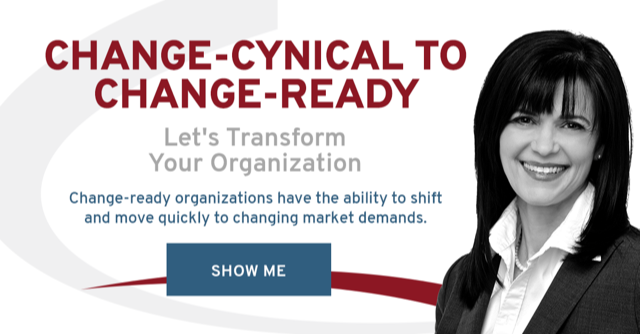Do Your Leaders and Managers Have the Energy to Go the Distance?
Perseverance is one characteristic demonstrated by leaders who are able to create and sustain healthy organizational change. Before you launch any change, you need to ask one question: how will we (the leaders and managers) maintain our energy and perseverance to go the distance?
Answering this question doesn’t mean pushing through a change at any cost. It means planning so that you have the energy and perseverance to support and enable employees to move as comfortably as possible through the full scope of the change process.
Launching Change is the Easy Part
Any leader or manager in any organization can launch change. But not every leader can ensure the change they launch will stick or add value. A 2002 study conducted by McKinsey found 58 percent of companies failed to achieve the intended result. The same study found that 20 percent of change captured less than a third of the value expected from that change. When we consider that every change should help your organization and your employees improve their ability to handle subsequent changes, your risk related to change increases.
 It takes less energy to launch an organizational change than it does to adopt the new activities and behaviours needed to achieve its intended value. Leaders who fail to recognize this can find themselves in a critical energy crisis. And the crisis comes at the time when you most need your energy.
It takes less energy to launch an organizational change than it does to adopt the new activities and behaviours needed to achieve its intended value. Leaders who fail to recognize this can find themselves in a critical energy crisis. And the crisis comes at the time when you most need your energy.
Your role during change is to go the distance. This means you must continue to support, encourage, and enable adoption until you have evidence that the change (behaviours, activities, or work processes) has become the norm. Without knowledge of the change process, it’s easy to underestimate the energy and time adoption takes.
It’s helpful to focus on why you may experience an energy crisis during change before we talk about ways to help your employees handle change.
Change or adopting something new is hard. It’s hard for everyone. Leaders tend to underestimate the magnitude of the change. Resistance, or rather your belief that people resist change, may also contribute to an energy crisis.
The idea that some people resist change and others don’t is a fallacy. Dr. Kilian Bennebroek Gravenhorst, founder of the Change Monitor, observed that resistance to change seems to apply to everyone except top managers, as if they were a special group with super human abilities. Yet it is more likely that resistance to change did not occur in this group because they are usually the ones who decide to make the change.
When you approach change from a resistance mentality, you short circuit the change process. It’s easy then, to become frustrated or interpret the normal human reaction to change as resistance. When what you are experiencing may be your employees lack of preparation for the change.
If your goal is healthy organizational change, and I hope it is, then ask yourself: how will we maintain the energy needed to go the distance? This is a critical question.
Here Are Three Things That Can Help You Avoid an Energy Crisis When You Are Leading and Managing Change:
- Remember leaders start changes first. By the time you have decided to talk to your employees, your leaders have likely already been working on the change for months. It’s no longer new to them. As your change launches and you get middle managers on board, your leaders are already much further ahead on the change continuum. The same happens when more employees are first introduced to the change. What’s old to you is new to them. It’s helpful to consider the announcement or launching of your change as a reboot of your starting point. The people affected (change-recipients) will (if they are going to adopt) need to move through the same process you already have moved through to conclude the change is needed and to understand the intended outcome. That’s your starting place for any change. It’s not the previous work you did to get ready to announce or launch the change, although all of that work is necessary for you to be ready to launch.
- Check-in with yourself during the change process. Sometimes we are quick to label and make judgments about the way others are responding to a change. It’s helpful to ask:
- Why am I feeling tired or frustrated (or any other emotional response you are experiencing)?
- Where was I when I first thought or heard about this change?
- What would this change look like for me if I were in a similar situation (new to the change)?
- Take a pause and reflect. Sometimes when we are in the guts of the change—that period where we can’t go back, but the new behaviours are not yet comfortable—taking a pause to reflect is the best action a leader can take. It’s a chance to re-assess what’s happening, re-group, and recharge our batteries.
 One vice president I worked with did exactly that during a large change initiative. He recognized his own frustration, and his leaders were experiencing a backlash from the discomfort of the change. He didn’t stop the change or push harder. He acknowledged the discomfort and worked with his leaders to assess how could they ease some of the discomfort while still moving forward. That’s exactly what we did. People felt heard, and they were able to move forward with the new activities and adopt the new system.
One vice president I worked with did exactly that during a large change initiative. He recognized his own frustration, and his leaders were experiencing a backlash from the discomfort of the change. He didn’t stop the change or push harder. He acknowledged the discomfort and worked with his leaders to assess how could they ease some of the discomfort while still moving forward. That’s exactly what we did. People felt heard, and they were able to move forward with the new activities and adopt the new system.
Making the time to prepare your employees for change, to check-in with your own response during the change, and to reflect on both the process and progress will help you maintain the energy needed to sustain the changes in your organization. Only the organizational changes that are sustained over time give you a return on your investment.
Dr. Dawn-Marie Turner
Turner Change Management – Think Transition: Turn change from a liability to an asset



